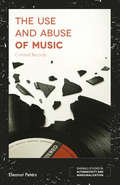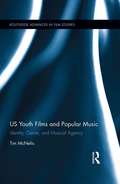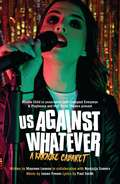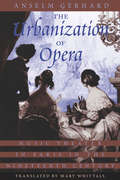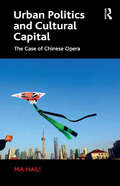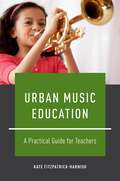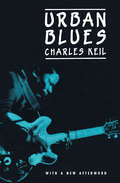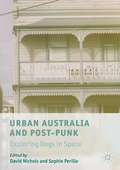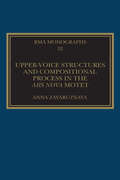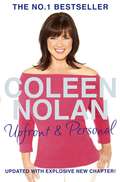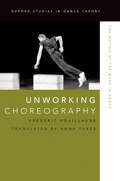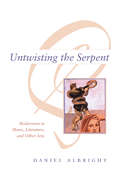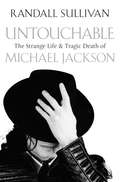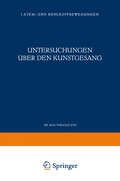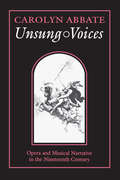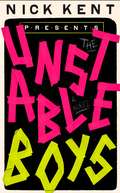- Table View
- List View
The Use and Abuse of Music: Criminal Records (Emerald Studies in Alternativity and Marginalization)
by Eleanor PetersMusic may not be an obvious area for a criminologist's attention, but there are many areas appropriate for analysis in the relationship between sound, music, rights and harm. The Use and Abuse of Music: Criminal Records explores how music is utilised to include, exclude, dominate and silence. Analysing the connection between music and crime from an expressly critical criminological perspective, the book is divided into three main parts. Firstly, focusing on the concept of 'harmful' or deviant music, genres such as UK drill music and heavy metal are examined to highlight the connections between certain genres and criminalisation. Moving away from specifics of genre, the second section considers the use of music in war and conflict. Finally, the book reflects on the censorship and silencing of subcultures and individuals through music, highlighting the inequalities surrounding who is permitted to make noise which is often exemplified by racist, sexist and prejudicial actions. This illuminating exploration of the deviant and transgressive nature of music is ideal for researchers, scholars and students working within the fields of criminology, sociology and musicology.
The Use and Abuse of Music: Criminal Records (Emerald Studies in Alternativity and Marginalization)
by Eleanor PetersMusic may not be an obvious area for a criminologist's attention, but there are many areas appropriate for analysis in the relationship between sound, music, rights and harm. The Use and Abuse of Music: Criminal Records explores how music is utilised to include, exclude, dominate and silence. Analysing the connection between music and crime from an expressly critical criminological perspective, the book is divided into three main parts. Firstly, focusing on the concept of 'harmful' or deviant music, genres such as UK drill music and heavy metal are examined to highlight the connections between certain genres and criminalisation. Moving away from specifics of genre, the second section considers the use of music in war and conflict. Finally, the book reflects on the censorship and silencing of subcultures and individuals through music, highlighting the inequalities surrounding who is permitted to make noise which is often exemplified by racist, sexist and prejudicial actions. This illuminating exploration of the deviant and transgressive nature of music is ideal for researchers, scholars and students working within the fields of criminology, sociology and musicology.
US Youth Films and Popular Music: Identity, Genre, and Musical Agency (Routledge Advances in Film Studies)
by Tim McNelisThis book brings theory from popular music studies to an examination of identity and agency in youth films while building on, and complementing, film studies literature concerned with genre, identity, and representation. McNelis includes case studies of Hollywood and independent US youth films that have had commercial and/or critical success to illustrate how films draw on specific discourses surrounding popular music genres to convey ideas about gender, race, ethnicity, sexuality, and other aspects of identity. He develops the concept of ‘musical agency’, a term he uses to discuss the relationship between film music and character agency, also examining the music characters listen to and discuss, as well as musical performances by the characters themselves
US Youth Films and Popular Music: Identity, Genre, and Musical Agency (Routledge Advances in Film Studies)
by Tim McNelisThis book brings theory from popular music studies to an examination of identity and agency in youth films while building on, and complementing, film studies literature concerned with genre, identity, and representation. McNelis includes case studies of Hollywood and independent US youth films that have had commercial and/or critical success to illustrate how films draw on specific discourses surrounding popular music genres to convey ideas about gender, race, ethnicity, sexuality, and other aspects of identity. He develops the concept of ‘musical agency’, a term he uses to discuss the relationship between film music and character agency, also examining the music characters listen to and discuss, as well as musical performances by the characters themselves
Us Against Whatever (Oberon Modern Plays)
by Maureen LennonAn electrifying cabaret about the places we keep in our hearts “We don’t wanna talk about Westminster or Farage or Brussels. We want to talk about us. Here. Cos we’re the bit that matters.” Anna is starting to think she made a mistake in moving to Hull. Steph sees her city changing and misses her dad. Both are looking for somewhere to call home and something to believe in. And Sheila? She’s determined to bring people together again, the only way she knows how – karaoke! ‘Cause what we need right now is to get up on our feet, grab a mic together and belt out a ballad after a pint or five. From Pride in Poland and Windass at Wembley, to City of Culture and Brexit Britain, Us Against Whatever is an electrifying cabaret about the places we keep in our hearts, with support from Hull’s finest voices – you! Setting fire to expectations of what a night at the theatre can be, this is the latest call to arms from the company behind 2017’s award-winning All We Ever Wanted Was Everything. Us Against Whatever was developed with the support of the National Theatre and British Council.
The Urbanization of Opera: Music Theater in Paris in the Nineteenth Century
by Anselm GerhardAnselm Gerhard explores the origins of grand opéra, arguing that its aesthetic innovations (both musical and theatrical) reflected not bourgeois tastes, but changes in daily life and psychological outlook produced by the rapid urbanization of Paris. These larger urban and social concerns—crucial to our understanding of nineteenth-century opera—are brought to bear in fascinating discussions of eight operas composed by Rossini, Auber, Meyerbeer, Verdi, and Louise Bertin. "An invaluable look at this fascinating genre."—George W. Loomis, Opera News
Urban Politics and Cultural Capital: The Case of Chinese Opera
by Ma HailiThis book tells the story of how a regional Chinese theatrical form, Shanghai Yue Opera, evolved from the all-male ’beggar’s song’ of the early twentieth century to become the largest all-female opera form in the nation, only to face increasing pressure to survive under Chinese political and economic reforms in the new millennium. Previous publications have focused mainly on the historical development of Chinese theatre, with emphasis placed on Beijing opera. This is the first book to take an interdisciplinary approach to the story of the Shanghai Yue Opera, bringing history, arts management, central and regional government policy, urbanisation, gender, media, and theatre artistic development in one. Through the story of the Shanghai Yue Opera House market reform this book facilitates an understanding of the complex Chinese political economic situation in post-socialist China. This book suggests that as state art institutions are key organs of the Communist party gaining legitimacy, the vigorous evolution and struggle of the Shanghai Yue Opera house in fact directly mirrors the Communist Party internal turmoil in the new millennium to gain its own legitimacy and survival.
Urban Politics and Cultural Capital: The Case of Chinese Opera
by Ma HailiThis book tells the story of how a regional Chinese theatrical form, Shanghai Yue Opera, evolved from the all-male ’beggar’s song’ of the early twentieth century to become the largest all-female opera form in the nation, only to face increasing pressure to survive under Chinese political and economic reforms in the new millennium. Previous publications have focused mainly on the historical development of Chinese theatre, with emphasis placed on Beijing opera. This is the first book to take an interdisciplinary approach to the story of the Shanghai Yue Opera, bringing history, arts management, central and regional government policy, urbanisation, gender, media, and theatre artistic development in one. Through the story of the Shanghai Yue Opera House market reform this book facilitates an understanding of the complex Chinese political economic situation in post-socialist China. This book suggests that as state art institutions are key organs of the Communist party gaining legitimacy, the vigorous evolution and struggle of the Shanghai Yue Opera house in fact directly mirrors the Communist Party internal turmoil in the new millennium to gain its own legitimacy and survival.
URBAN MUSIC EDUCATION C: A Practical Guide for Teachers
by Kate Fitzpatrick-HarnishThe prevailing discourse surrounding urban music education suggests the deficit-laden notion that urban school settings are "less than," rather than "different than," their counterparts. Through the lens of contextually-specific teaching, this book provides a counternarrative on urban music education that encourages urban music teachers to focus on the strengths of their students as their primary resource. Through a combination of research-based strategies and practical suggestions from the author's own experience teaching music in urban settings, the book highlights important issues for teachers to consider, such as culturally relevant pedagogy, the "opportunity gap," race, ethnicity, socioeconomic status, musical content, curricular change, music program development, student motivation, and strategies for finding inspiration and support. Throughout the book, the stories of five highly successful urban music teachers are highlighted, providing practical, real-world advice for music teachers across the domains of general, choral, band, and string music teaching. Recognizing that the term "urban" can encompass a wide variety of different school and community settings, this book challenges all teachers who work in under-served and under-resourced settings to take a critical look at their own music classroom and work to tailor their pedagogy to meet the particular needs of their students.
Urban Music Education: A Practical Guide for Teachers
by Kate Fitzpatrick-HarnishThe prevailing discourse surrounding urban music education suggests the deficit-laden notion that urban school settings are "less than," rather than "different than," their counterparts. Through the lens of contextually-specific teaching, this book provides a counternarrative on urban music education that encourages urban music teachers to focus on the strengths of their students as their primary resource. Through a combination of research-based strategies and practical suggestions from the author's own experience teaching music in urban settings, the book highlights important issues for teachers to consider, such as culturally relevant pedagogy, the "opportunity gap," race, ethnicity, socioeconomic status, musical content, curricular change, music program development, student motivation, and strategies for finding inspiration and support. Throughout the book, the stories of five highly successful urban music teachers are highlighted, providing practical, real-world advice for music teachers across the domains of general, choral, band, and string music teaching. Recognizing that the term "urban" can encompass a wide variety of different school and community settings, this book challenges all teachers who work in under-served and under-resourced settings to take a critical look at their own music classroom and work to tailor their pedagogy to meet the particular needs of their students.
Urban Blues
by Charles KeilCharles Keil examines the expressive role of blues bands and performers and stresses the intense interaction between performer and audience. Profiling bluesmen Bobby Bland and B. B. King, Keil argues that they are symbols for the black community, embodying important attitudes and roles—success, strong egos, and close ties to the community. While writing Urban Blues in the mid-1960s, Keil optimistically saw this cultural expression as contributing to the rising tide of raised political consciousness in Afro-America. His new Afterword examines black music in the context of capitalism and black culture in the context of worldwide trends toward diversification. "Enlightening. . . . [Keil] has given a provocative indication of the role of the blues singer as a focal point of ghetto community expression."—John S. Wilson, New York Times Book Review "A terribly valuable book and a powerful one. . . . Keil is an original thinker and . . . has offered us a major breakthrough."—Studs Terkel, Chicago Tribune "[Urban Blues] expresses authentic concern for people who are coming to realize that their past was . . . the source of meaningful cultural values."—Atlantic "An achievement of the first magnitude. . . . He opens our eyes and introduces a world of amazingly complex musical happening."—Robert Farris Thompson, Ethnomusicology "[Keil's] vigorous, aggressive scholarship, lucid style and sparkling analysis stimulate the challenge. Valuable insights come from treating urban blues as artistic communication."—James A. Bonar, Boston Herald
Urban Blues
by Charles KeilCharles Keil examines the expressive role of blues bands and performers and stresses the intense interaction between performer and audience. Profiling bluesmen Bobby Bland and B. B. King, Keil argues that they are symbols for the black community, embodying important attitudes and roles—success, strong egos, and close ties to the community. While writing Urban Blues in the mid-1960s, Keil optimistically saw this cultural expression as contributing to the rising tide of raised political consciousness in Afro-America. His new Afterword examines black music in the context of capitalism and black culture in the context of worldwide trends toward diversification. "Enlightening. . . . [Keil] has given a provocative indication of the role of the blues singer as a focal point of ghetto community expression."—John S. Wilson, New York Times Book Review "A terribly valuable book and a powerful one. . . . Keil is an original thinker and . . . has offered us a major breakthrough."—Studs Terkel, Chicago Tribune "[Urban Blues] expresses authentic concern for people who are coming to realize that their past was . . . the source of meaningful cultural values."—Atlantic "An achievement of the first magnitude. . . . He opens our eyes and introduces a world of amazingly complex musical happening."—Robert Farris Thompson, Ethnomusicology "[Keil's] vigorous, aggressive scholarship, lucid style and sparkling analysis stimulate the challenge. Valuable insights come from treating urban blues as artistic communication."—James A. Bonar, Boston Herald
Urban Blues
by Charles KeilCharles Keil examines the expressive role of blues bands and performers and stresses the intense interaction between performer and audience. Profiling bluesmen Bobby Bland and B. B. King, Keil argues that they are symbols for the black community, embodying important attitudes and roles—success, strong egos, and close ties to the community. While writing Urban Blues in the mid-1960s, Keil optimistically saw this cultural expression as contributing to the rising tide of raised political consciousness in Afro-America. His new Afterword examines black music in the context of capitalism and black culture in the context of worldwide trends toward diversification. "Enlightening. . . . [Keil] has given a provocative indication of the role of the blues singer as a focal point of ghetto community expression."—John S. Wilson, New York Times Book Review "A terribly valuable book and a powerful one. . . . Keil is an original thinker and . . . has offered us a major breakthrough."—Studs Terkel, Chicago Tribune "[Urban Blues] expresses authentic concern for people who are coming to realize that their past was . . . the source of meaningful cultural values."—Atlantic "An achievement of the first magnitude. . . . He opens our eyes and introduces a world of amazingly complex musical happening."—Robert Farris Thompson, Ethnomusicology "[Keil's] vigorous, aggressive scholarship, lucid style and sparkling analysis stimulate the challenge. Valuable insights come from treating urban blues as artistic communication."—James A. Bonar, Boston Herald
Urban Blues
by Charles KeilCharles Keil examines the expressive role of blues bands and performers and stresses the intense interaction between performer and audience. Profiling bluesmen Bobby Bland and B. B. King, Keil argues that they are symbols for the black community, embodying important attitudes and roles—success, strong egos, and close ties to the community. While writing Urban Blues in the mid-1960s, Keil optimistically saw this cultural expression as contributing to the rising tide of raised political consciousness in Afro-America. His new Afterword examines black music in the context of capitalism and black culture in the context of worldwide trends toward diversification. "Enlightening. . . . [Keil] has given a provocative indication of the role of the blues singer as a focal point of ghetto community expression."—John S. Wilson, New York Times Book Review "A terribly valuable book and a powerful one. . . . Keil is an original thinker and . . . has offered us a major breakthrough."—Studs Terkel, Chicago Tribune "[Urban Blues] expresses authentic concern for people who are coming to realize that their past was . . . the source of meaningful cultural values."—Atlantic "An achievement of the first magnitude. . . . He opens our eyes and introduces a world of amazingly complex musical happening."—Robert Farris Thompson, Ethnomusicology "[Keil's] vigorous, aggressive scholarship, lucid style and sparkling analysis stimulate the challenge. Valuable insights come from treating urban blues as artistic communication."—James A. Bonar, Boston Herald
Urban Australia and Post-Punk: Exploring Dogs in Space
by David Nichols Sophie PerilloRichard Lowenstein’s 1986 masterpiece Dogs in Space was and remains controversial, divisive, compelling and inspirational. Made less than a decade after the events it is based on, using many of the people involved in those events as actors, the film explored Melbourne’s ‘postpunk’ counterculture of share houses, drugs and decadence. Amongst its ensemble cast was Michael Hutchence, one of the biggest music stars of the period, in his acting debut. This book is a collection of essays exploring the place, period and legacy of Dogs in Space, by people who were there or who have been affected by this remarkable film. The writers are musicians, actors and artists and also academics in heritage, history, urban planning, gender studies, geography, performance and music. This is an invaluable resource for anyone passionate about Australian film, society, culture, history, heritage, music and art.
Upper-Voice Structures and Compositional Process in the Ars Nova Motet (Royal Musical Association Monographs)
by Anna ZayaruznayaIn the motets of Philippe de Vitry, Guillaume de Machaut, and their contemporaries, tenors have often been characterized as the primary shaping forces, prior in conception as well as in construction to the upper voices. Tenors are shaped by the interaction of talea and color, medieval terms now used to refer to the independent repetition of rhythms and pitches, respectively. The presence in the upper voices of the periodically repeating rhythmic patterns, often referred to as "isorhythm," has been characterized as an amplification of tenor structure. But a fresh look at the medieval treatises suggests a revised analytical vocabulary: for many fourteenth- and fifteenth-century writers, both color and talea involved rhythmic repetition, the latter in the upper voices specifically. And attention to upper-voice taleae independently of tenor structures brings renewed emphasis to the significant portion of the repertory in which upper voices evince formal schemes that differ from those in the tenors. These structures in turn suggest a revision of the presumed compositional process for motets, implying that in some cases upper-voice text and forms may have preceded the selection and organization of tenors. Such revisions have implications for hermeneutic endeavors, since not only the forms of motet voices but the meanings of their texts change, depending on whether analysis proceeds from the tenor up, or from the top down. Where the presumed compositional and structural primacy afforded to tenors has encouraged a strand of interpretation that reads the upper-voice poetry as conforming to, and amplifying, the tenor text snippets and their liturgical contexts, a "bottom-down" view casts tenors in a supporting role and reveals the poetic impulse of the upper voices as the organizing principle of motets.
Upper-Voice Structures and Compositional Process in the Ars Nova Motet (Royal Musical Association Monographs)
by Anna ZayaruznayaIn the motets of Philippe de Vitry, Guillaume de Machaut, and their contemporaries, tenors have often been characterized as the primary shaping forces, prior in conception as well as in construction to the upper voices. Tenors are shaped by the interaction of talea and color, medieval terms now used to refer to the independent repetition of rhythms and pitches, respectively. The presence in the upper voices of the periodically repeating rhythmic patterns, often referred to as "isorhythm," has been characterized as an amplification of tenor structure. But a fresh look at the medieval treatises suggests a revised analytical vocabulary: for many fourteenth- and fifteenth-century writers, both color and talea involved rhythmic repetition, the latter in the upper voices specifically. And attention to upper-voice taleae independently of tenor structures brings renewed emphasis to the significant portion of the repertory in which upper voices evince formal schemes that differ from those in the tenors. These structures in turn suggest a revision of the presumed compositional process for motets, implying that in some cases upper-voice text and forms may have preceded the selection and organization of tenors. Such revisions have implications for hermeneutic endeavors, since not only the forms of motet voices but the meanings of their texts change, depending on whether analysis proceeds from the tenor up, or from the top down. Where the presumed compositional and structural primacy afforded to tenors has encouraged a strand of interpretation that reads the upper-voice poetry as conforming to, and amplifying, the tenor text snippets and their liturgical contexts, a "bottom-down" view casts tenors in a supporting role and reveals the poetic impulse of the upper voices as the organizing principle of motets.
Upfront and Personal: The Autobiography
by Coleen NolanWriting with the warmth and humour that have made her so popular, Coleen describes her eventful life, from joining her sisters' band The Nolans when she was only nine to growing up in the spotlight as they went on to chart-topping success around the world. Coleen also reveals how she coped with her tumultuous marriage to television star Shane Richie and how, after they split she was left a single parent struggling to get through each day. She landed the job of presenter on This Morning and was just finding her feet when she was sacked, plunging her into depression as she lost all confidence. A way out finally came in the form of chat show Loose Women, where Coleen reclaimed her place in the nation's hearts. Today she is happily married and an inspiration to women everywhere who believed their 'best days' were behind them. Entertaining, funny and shockingly honest, this book is sure to appeal to her many fans old and new.
UNWORKING CHOREOGRAPHY OSDT C: The Notion of the Work in Dance (Oxford Studies in Dance Theory)
by Frédéric PouillaudeThere is no archive or museum of human movement, no place where choreographies can be collected and conserved in pristine form. The central consequence of this is the incapacity of philosophy and aesthetics to think of dance as a positive and empirical art. In the eyes of philosophers, dance refers to a space other than art, considered both more frivolous and more fundamental than the artwork without ever quite attaining the status of a work. Unworking Choreography develops this idea and postulates an unworking as evidenced by a conspicuous absence of references to actual choreographic works within philosophical accounts of dance; the late development and partial dominance of the notion of the work in dance in contrast to other art forms such as painting, music, and theatre; the difficulties in identifying dance works given a lack of scores and an apparent resistance within the art form to the possibility of notation; and the questioning of ends of dance in contemporary practice and the relativisation of the very idea that dance artistic or choreographic processes aim at work production.
Unworking Choreography: The Notion of the Work in Dance (Oxford Studies in Dance Theory)
by Frédéric PouillaudeThere is no archive or museum of human movement, no place where choreographies can be collected and conserved in pristine form. The central consequence of this is the incapacity of philosophy and aesthetics to think of dance as a positive and empirical art. In the eyes of philosophers, dance refers to a space other than art, considered both more frivolous and more fundamental than the artwork without ever quite attaining the status of a work. Unworking Choreography develops this idea and postulates an unworking as evidenced by a conspicuous absence of references to actual choreographic works within philosophical accounts of dance; the late development and partial dominance of the notion of the work in dance in contrast to other art forms such as painting, music, and theatre; the difficulties in identifying dance works given a lack of scores and an apparent resistance within the art form to the possibility of notation; and the questioning of ends of dance in contemporary practice and the relativisation of the very idea that dance artistic or choreographic processes aim at work production.
Untwisting the Serpent: Modernism in Music, Literature, and Other Arts
by Daniel AlbrightFrom its dissonant musics to its surrealist spectacles (the urinal is a violin!), Modernist art often seems to give more frustration than pleasure to its audience. In Untwisting the Serpent, Daniel Albright shows that this perception arises partly because we usually consider each art form in isolation, even though many of the most important artistic experiments of the Modernists were collaborations involving several media—Igor Stravinsky's The Rite of Spring is a ballet, Gertrude Stein's Four Saints in Three Acts is an opera, and Pablo Picasso turned his cubist paintings into costumes for Parade. Focusing on collaborations with a musical component, Albright views these works as either figures of dissonance that try to retain the distinctness of their various media (e.g. Guillaume Apollinaire's Les Mamelles de Tirésias) or figures of consonance that try to lose themselves in some total effect (e.g. Arnold Schoenberg's Erwartung). In so doing he offers a fresh picture of Modernism, and provides a compelling model for the analysis of all artistic collaborations. Untwisting the Serpent is the recipient of the 2001 Susanne M. Glasscock Humanities Book Prize for Interdisciplinary Scholarship of the Center for Humanities Research at Texas A&M University.
Untouchable: The Strange Life and Tragic Death of Michael Jackson (Books That Changed The World Ser.)
by Randall SullivanDrawing on never-before-seen material, this definitive biography exposes the true extent of the Jackson family's dysfunctionality -- evidence of which is still in the public eye as they dispute the star's willJackson was the most talented, richest, and most famous pop star on the planet. But the outpouring of emotion that followed his loss was bittersweet. Dogged by scandal for over fifteen years, and undone by his own tendency to trust the wrong people, Jackson had become untouchable in many quarters, a fact that wounded him deeply. Now, drawing on unprecedented access to friends, enemies, employees, and associates of Jackson, Randall Sullivan delivers an intimate, unflinching, and deeply human portrait of a man who was never quite understood by the media, his fans, or even those closest to him. Untouchable promises to be a profound investigation into the enigma that was Michael Jackson.
Untersuchungen über den Kunstgesang: I. Atem- und Kehlkopfbewegungen
by Max NadolecznyDieser Buchtitel ist Teil des Digitalisierungsprojekts Springer Book Archives mit Publikationen, die seit den Anfängen des Verlags von 1842 erschienen sind. Der Verlag stellt mit diesem Archiv Quellen für die historische wie auch die disziplingeschichtliche Forschung zur Verfügung, die jeweils im historischen Kontext betrachtet werden müssen. Dieser Titel erschien in der Zeit vor 1945 und wird daher in seiner zeittypischen politisch-ideologischen Ausrichtung vom Verlag nicht beworben.
Unsung Voices: Opera and Musical Narrative in the Nineteenth Century
by Carolyn AbbateWho "speaks" to us in The Sorcerer's Apprentice, in Wagner's operas, in a Mahler symphony? In asking this question, Carolyn Abbate opens nineteenth-century operas and instrumental works to new interpretations as she explores the voices projected by music. The nineteenth-century metaphor of music that "sings" is thus reanimated in a new context, and Abbate proposes interpretive strategies that "de-center" music criticism, that seek the polyphony and dialogism of music, and that celebrate musical gestures often marginalized by conventional music analysis.
The Unstable Boys: A Novel
by Nick KentLondon 1968:The Unstable Boys are the name on every music insider's lips and tipped to follow in the footsteps of the Beatles and the Rolling Stones. This is their chance to hit the bigtime. They don't know they're about to be obliterated by a series of tragedies and a chaotic breakup that puts paid to the band's starry-eyed dreams of stratospheric success. One day you're the dog's bollocks; the next day you're a nobody - fame is a fickle friend.London 2016:Bestselling crime writer Michael Martindale has reached breaking point. Estranged from his wife and children following the very public fallout of his disastrous affair, he is alone, with only his self-pity to keep him warm at night. Until he makes the mistake of publicly declaring his admiration for his teenage musical obsession, the Unstable Boys. When the band's twisted and feral frontman, the Boy, turns up on his doorstep, Martindale quickly learns that sometimes you should be careful what you wish for.Razor-sharp and laced with a caustic wit, The Unstable Boys is a dark comic caper with an unmistakeable musicality from legendary music journalist Nick Kent.
